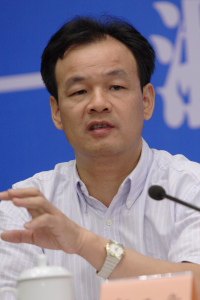| A coastal province in East China, Zhejiang has one of the fastest growing economies in China. That's because its success is based on innovation and high-tech industries, said Qiu Feizhang, deputy director of the Zhejiang Provincial Science and Technology Department at a news briefing on September 17.

Qiu Feizhang, deputy director of the Zhejiang Provincial Science and Technology Department, answers a question at a news briefing in Hangzhou, East China's Zhejiang Province, on September 17, 2007. [chinadaily.com.cn] |
As of the end of this June, the output value of Zhejiang's high-tech sector reached 260 billion yuan ($34.39 billion), a year-on-year increase of 20 percent. Composite materials contribute about 220 billion yuan, a year-on-year increase of 41.2 percent. These composite materials include those for environmental protection, petrochemical equipment and vehicle production.
According to the State Intellectual Property Office, in the first half of this year, Zhejiang Province ranked third in the country for the number of applications for patents, and second for the number of patents authorized.
Enterprises and local governments have made a total investment of about 3.9 billion yuan. Even multinationals, such as Motorola, Nokia, and Samsung have research centers in Zhejiang.
To encourage more innovation, the provincial government has improved the subsidy system for scientific and technological projects. Those promising enterprises as the main fundraisers can get extra financial support and interest subsidies. Also, since 1978, Zhejiang's gross domestic product (GDP) has remained an annual average growth rate of 13 percent. In the first six months of 2007, electromechanical products contributed to 43.76 percent, and textile exports 40.35 percent.The electromechanical industry and textile industry are two pillar industries of Zhejiang Province.
The Zhejiang Institute of Textile Industry is a research center in Shaoxing County. The research center serves over 2,000 textile companies in the area, providing information on the latest fabrics, patterns, equipment, human resources training, and quality testing.

Zheng Yifang, Deputy Director of the Economy and Trade Commission of Zhejiang Province, speaks at a press conference in Hangzhou, capital of East China's Zhejiang Province on September 17, 2007.[chinadaily.com.cn] | Another challenge for Zhejiang's enterprises are trade barriers set by foreign countries. And some of the export restrictions are due to upgrades in technologies. For example, Wenzhou, a city in Zhejiang, exports the largest number of lighters to Europe, and the European Union has a Children Resistance Act to restrict low-priced lighters into the European market, fearing those kinds can be easily opened by children. But the provincial government is confident it is prepared to cope with trade disputes due to its failure to meet international requirements and standards.
“We are developing an information platform to provide related information to exporting enterprises so that they can better cope with the challenges,” Zheng Yifang, Deputy Director of the Economy and Trade Commission of Zhejiang Province told China Daily website. “And the key is technological self innovation.”
As the main contributors to the provincial economy, small- and medium-sized enterprises (SME) are playing an active role in technological innovation. Zhejiang Province's regulations called “Promoting the Development of SMEs” are established to promote their capability of independent innovation.
The province is on its way from being a follower to a brand maker, Zheng said.
|


